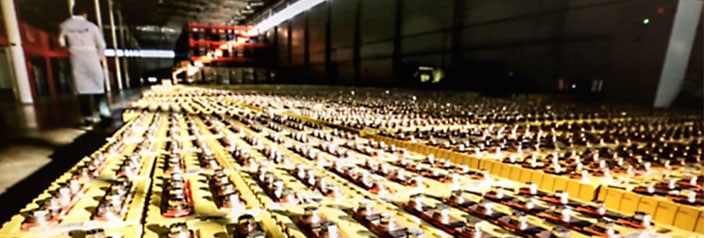By Glenn Dyer, ShareCafé
China has spent the past year or more monstering Australia and Australian companies – from the government to iron ore and wine producers, to barley, beef, lobsters and especially coal – leaving the country now regarded as an unreliable and volatile trading partner.
And yet the ties between both countries continue, especially in the strategically important areas of lithium mining and processing.
It’s a case of need and greed on the part of the Chinese companies and government.
Lithium is not so rare that China has to buy from Australia and deal with local companies. Countries like Chile, Argentina and the US have produced lithium for years – mostly from brines.
Rio Tinto has unearthed a major deposit in Serbia and plans to turn it into a massive mine to produce product for the huge European market.
And yet, despite the current uncertainties with Australia, China still looks to us for raw materials, with lithium a major new area of demand.
Just as with iron ore, that attraction is all about proximity, a stable economy and mining sector here with free markets, plenty of capital and willing risk-takers in business.
Take two announcements from major Chinese companies in the past week or so.
The first means Chinese giant Tianqi Lithium Corp can thank Australian nickel and gold miner IGO for helping the Chinese company produce its first net profit in two years.
Tianqi is one of the world’s top lithium producers, but wouldn’t have been in such a position if it hadn’t been for the $US1.4 billion deal with IGO covering the Greenbushes mine and Kwinana refinery in late 2020.
The deal saw IGO purchase a 49% stake in Tianqi Lithium Energy Australia for $A1.9 billion.
That left IGO with a 25% interest in the Greenbushes lithium mining and processing operation in Western Australia – the largest operating lithium mine in the world. IGO also got interest in Tianqi’s Kwinana lithium hydroxide plant, located south of Perth.
Tianqi said in a recent filing to the Shenzhen Stock Exchange its net income was 85.8 million yuan ($US13.3 million) for the first half of 2021, up from a loss of 696.6 million yuan a year earlier.
Reuters said the result implies a second-quarter profit of 333.7 million yuan, after a 247.9-million-yuan loss in January-March, marking the three months to Tianqi’s best quarterly result since the fourth quarter of 2018.
Tianqi posted seven straight quarterly losses from mid-2019 after a precipitous three-year plunge in lithium prices – mainly driven by oversupply – left the company short of funds and facing default on billions of dollars in loans.
But the December 2020 deal with IGO saved it from collapse, or as Reuters reported it, Tiangqi “secured a $1.4 billion lifeline investment in its Australian operations from IGO Ltd and has been boosted by a near tripling in lithium carbonate prices over the past 12 months as demand from the EV sector roars back.”
First-half revenues were 2.35 billion yuan, Tianqi said in the filing, up 25.13% from a year earlier.
IGO told the ASX earlier this month that it and its partner had produced the first batch of another battery chemical, lithium hydroxide, from the Kwinana plant. Work on that plant was halted for 2020 after Covid hit and that helped put great strain on the Chinese company’s financial position.
IGO said it expects the plant to be producing high-grade battery-quality material early in 2020 once the plant is up and running continuously.
IGO has major interest in nickel, copper and cobalt in WA. It is actively stalking Western Areas (in competition with Andrew Forrest’s Wyloo Metals).
Unlike its rivals, such as Pilbara Resources, IGO has a spread of renewable metals, some of which have a strong conventional user base in the wider economy and will continue to do so for decades to come.
That gives IGO diversification in case China arcs up again over lithium or some other perceived slight. Pilbara doesn’t, but has some big Chinese shareholders to protect it. IGO, though, does have Tianqi.
The second deal has seen Australia (and especially WA’s) proximity to China emerge as a key factor in Hainan Mining, a Chinese iron ore miner, choosing to locate a lithium processing plant in its home province on the country’s southeast coast.
Hainan Mininghas revealed plans to spend $US164 million on a plant to make battery-grade lithium hydroxide using lithium imports from Western Australia.
The company said the project would be located in Dongfang in its home island province of Hainan, in southern China, and would produce 20,000 tonnes a year of lithium hydroxide for use in batteries to be used by Electric Vehicles.
Record-high iron ore prices in the first six months of 2021 saw Hainan Mining’s January-June net profit surge almost 3,000% year-on-year.
“Hainan province is closer to Australia, the main source of spodumene raw material for the project,” the company said in a filing to the Shanghai Stock Exchange last week.
The island “has obvious maritime logistics advantages compared to Jiangxi and Sichuan, the main producers of lithium hydroxide in the mainland,” it said, adding that construction of the project would take 18 months.
Ganfeng Lithium and Tianqi Lithium respectively, two of the world’s top lithium producers are domiciled in China’s landlocked Jiangxi and Sichuan provinces.
As we saw from the first story, Tiangqi can thank IGO and Australia for its survival.
This article is general information and does not consider the circumstances of any investor or constitute advice.


